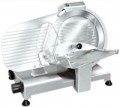Power
The total power consumption of the slicer. The value of this parameter is small — the performance of even the most powerful models usually does not exceed 200 W.
Almost all the power consumed is for operation of the engine, so the higher
it is, the more powerful the engine is installed in the slicer. Theoretically, the higher power allows you to better cope with solid and dense products, but in fact everything also depends on the characteristics of the knife — primarily its type (see below) and the quality of sharpening. Therefore, power data are more reference than practically significant, and this indicator has almost no effect on the quality of the slicer.
Blade diameter
The diameter of the blade of the knife supplied with the slicer. Knives are shaped like discs — accordingly, the diameter of the blade is actually equal to the diameter of the disc.
The larger the blade, the larger ingredients the device can handle at a time and the “larger” the cut slices can be. At the same time, in fact it is rarely necessary to use a slicer for very thick products. Therefore, even in the most “large-caliber” modern models, the knife diameter usually does not exceed 300 mm.
Compartment for cord
The presence
of a compartment for the power cord in the design of the slicer.
This feature greatly simplifies the storage and transportation of the device: the cord can be placed compactly inside the slicer body, and it will not hang out, cling to other objects and create other inconveniences. And in some models, the compartment may have devices for uniform winding, which makes it easier to lay the wire and avoid damage due to bending.

